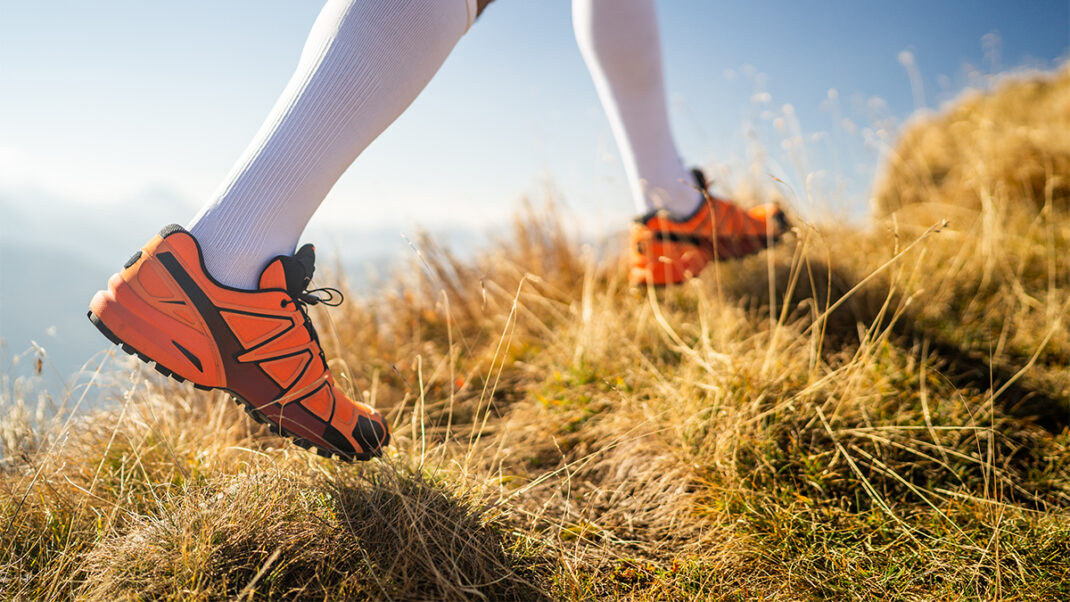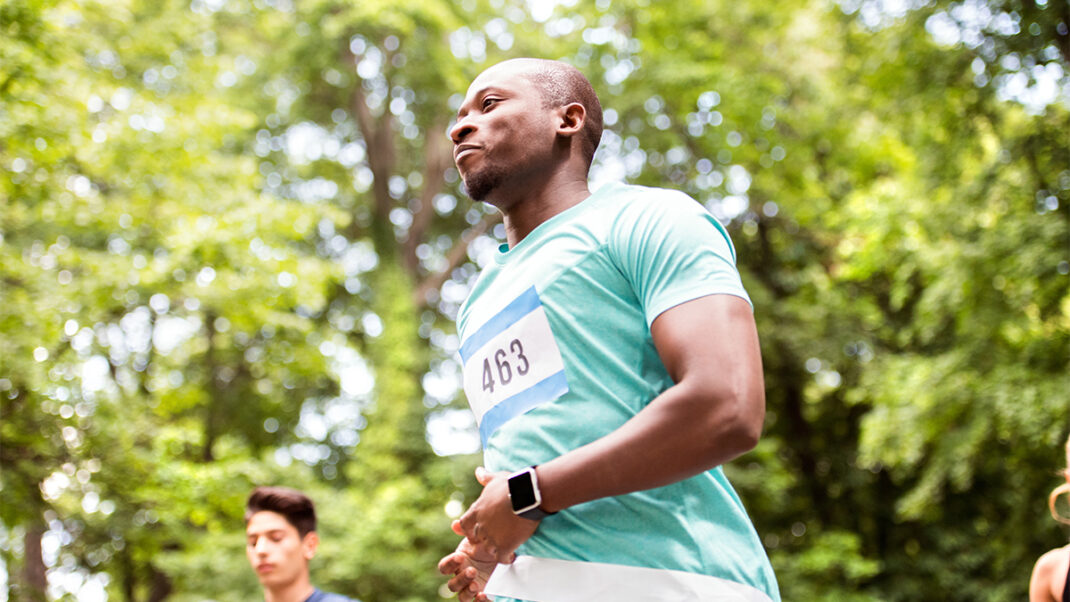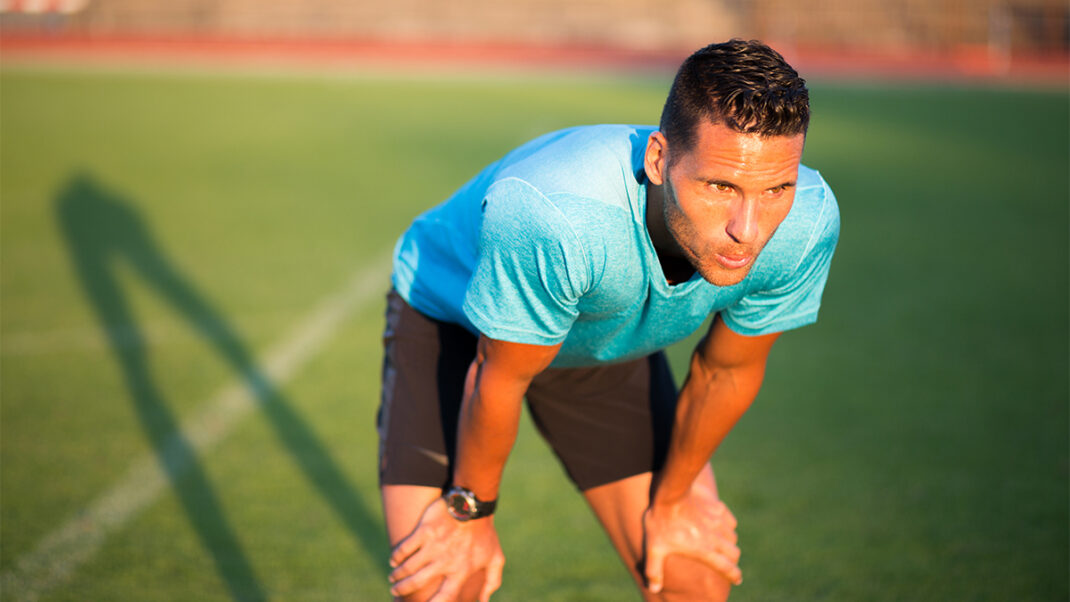Tennis Gets Wet
Water training provides three-dimensional resistance for superior aerobic and anaerobic conditioning and gains in speed, agility and quickness.

Perhaps a tennis-playing client of yours has recounted a treasured memory of being in “the zone.” Whether or not she was aware of it, the three major players in tennis were on court with her in those magic moments to help her produce winning points consistently.
“The three major players?” you ask. I am referring not to Andre Agassi and the Williams sisters
but to the three players that every aficionado and student of the game should know: speed,
quickness and balance. Tennis is a game not only of quick directional changes, explosive power
and precision but also of endurance; although points are quick and anaerobic in nature, a match
can last 1 to 4 hours, depending on the level of play. Proficiency in these physical qualities
can elevate your client’s game to a new level.
Training for a sport is usually divided into two parts: (1) the strength component, which
consists of a gym workout intended to support the body during the physical activity, and
(2) specific training, which consists of either playing the sport or drilling in a sport-specific
manner for functional and neuromuscular adaptation. This article covers tennis-specific
training by breaking down the sport’s movements and discussing simple and compound
water resistance training techniques.
What exercise equipment not only provides resistance in three dimensions
continuously but also allows a trainer to push a client to both anaerobic
and aerobic gains? To find out, grab your gear and follow me
to the water’s edge.
Why put tennis players in the pool? Water training develops
leg speed, strength, balance and endurance.
Water’s movement forces constant realignment of the body to a neutral spine to foster a strong adaptation of trunk strength in functional upright stance (Sanders 1998). Water’s buoyancy aids joint protection, especially important for junior and senior players. (Competitive juniors spend 3 to 5 hours a day training on and off court, and their joints take quite a beating from gravity and the mostly hard-court play.) Buoyancy also benefits touring pros and weekend warriors: It reduces gravity-induced stress, and the cool water feels great on hot, fatigued muscles.
Because water’s density creates resistance in all planes of motion, movements in water require greater muscle recruitment than do the same movements on land. Sport-specific water training involves the same movements that the player usually performs on land, but the properties of water make them resistive. (See “Understanding Water and Its Properties” on this page.) This resistance follows a functional path that develops the player’s strength and endurance. For example, when a client runs through water, the water’s resistance challenges the muscles that create the running motion, surpassing the resistive effect of a land-based, gravity-only drill. This overload along the runner’s path conditions the muscles and makes them stronger and
more enduring while reducing gravitational stress.
The correct use of water can facilitate physical and neuromuscular adaptation to movement that will translate into faster, stronger and more balanced play on the court. You can create exciting training protocols that almost certainly will propel your client’s game to new levels.
Players, coaches and trainers may have different ideas about what the most crucial area of tennis training should be. However, all of the coaches and trainers interviewed for this article agreed that footwork, speed, quickness and especially power are extremely important for successful match play.
Today, junior players spend a lot more time in the gym than did their predecessors of just 5 years ago. They train not for additional muscle bulk but for muscle balance, joint integrity and power. Lou Belken, coach of Arizona State University’s men’s tennis team, has his players start weight training in the fall for their dual-match season, which begins in January. His goal is not to build his players’ muscle mass but to develop their muscle balance for injury prevention.
Players need increased muscle strength to survive on the court also because the game itself has become faster and more powerful in recent years. “Strength has taken on new importance, especially in the women’s game,” says Rebecca Jensen, 1994 NCAA doubles champion and former top 100 doubles player on the pro women’s circuit. One look at the Williams sisters’ brand of power tennis, not to mention their physiques, and you can see how true that is.
Katrina Adams, a tennis pro once ranked among the top 100 singles
players and top 10 doubles players
in the world and the current high-performance coach for the U.S. Tennis Association, describes the body’s power chain at work in tennis: “Every stroke starts from the ground up. Power and strength come from the legs. Stability, power and strength come from the trunk. Finally, the arms need to be strong enough to support the racquet frame and maintain form against the constant pressure of the ball.”
Training Menu
Plyometrics
Water is a natural medium in which to develop the explosive and powerful movements needed to elevate a player’s game. On land, trainers use plyometric training to develop power for taking that explosive first step to the ball or exploding up into a serve or an overhead smash. Plyometrics on land use body mass and gravity to maximize the stretch reflex to teach muscles to produce maximum force faster.
Although its buoyancy and reduced gravity prevent water from eliciting
the same stretch reflex in muscles, jumping off the pool floor requires a great deal of power. Moreover, the client has to overcome the water with force and rapid acceleration, and the water supports the landing to minimize stress on the joints.
Another benefit of power work in the water is the constant realignment of the body, which enables it to continue to move up, out and back into the water. The crosscurrents and turbulence created by the repeated forceful movement in water stress realignment of the trunk, which trains the trunk muscles and helps develop balance.
Speed and Agility Training
Speed and quickness can make all the difference in a client’s level of play on the court. You can’t win if you can’t get to the ball, and the faster the athlete reaches the ball, the longer he has to set up his stroke. His ability to change direction quickly and regain balance before and after hitting the ball gives him even more time.
The muscular force necessary to overcome water resistance to achieve speed in water translates into swifter movement on land. Speed training on land is achieved by sprints. For example, suicide drills (running to cones spaced incrementally farther apart and returning to the starting line after touching each) develop both speed and quickness. However, although effective, such land drills have an inherent risk of injury to the ankles and knees. Water’s buoyant support negates much of that risk.
Agility drills in water improve a player’s ability to change direction and regain balance quickly. When a client moves through water, a current moving in the same direction is created. When cued to change direction, the athlete is forced to move against this strong current, which can be difficult to overcome. Such rapid directional changes in the water challenge and develop balance and foot speed.
These movements also develop an athlete’s confidence in her ability to move rapidly without losing control. Adams shares her experience of speed training in water: “Working against the resistance of water strengthens muscles and makes the athlete quicker outside the water. This is not only a physical adaptation but also a mental one.”
Endurance and Interval Training
Adams feels that the most prominent training component upon which all tennis players can improve is their endurance, especially because matches can last as long as 4 hours. A player who lacks the endurance to maintain good form gives his opponent the edge.
“Once you reach a certain level, stroke production is a level playing ground,” Jensen adds. “What make the difference in a player’s level are his ability to move to the ball and stamina to maintain his level of play throughout an entire match.”
Tennis is a game of repeated anaerobic intervals with rest intervals of as much as 25 seconds during games and 90 seconds between games. Water is an incredible medium for training muscular and cardiovascular endurance and training the body to respond to anaerobic activity and lactic acid buildup, the byproduct of strenuous muscular activity.
Interval training in water is the recommended method for improving cardiorespiratory endurance and muscular strength and endurance. Intervals are used initially in water training as muscular fatigue limits the athlete’s workout capacity. For tennis specificity, interval training in water is used to train for the sport’s work and recovery cycles. Once participants are conditioned to work in the water, the onset of blood lactate at a higher intensity is delayed and it is removed more rapidly during pool sessions. Another benefit
is an overall increase in muscular endurance at the cellular level. Because endurance improves in the water, where resistance is greater, the rating of perceived exertion (RPE) for land activities decreases (Frangolias & Rhodes 1995).
Tennis players can incur a litany of injuries. Wrist, elbow and shoulder joints are very susceptible because the ball is “whacked” with incredible power and the force of the ball striking the racquet is very stressful to those areas. Because trunk rotation is a foundation for stroke production, the back is also at risk of injury. Most players spend a great deal of time training their abdominal walls but should focus more on the back extensors and rotators. Additionally, knee and ankle injuries are almost always an issue in a start/stop, quick-change-of-direction sport, such as tennis.
Training tennis players in water provides resistance as they perform sport-specific movements. Consequently, it can strengthen a player’s trunk rotators, wrist, elbow, shoulder girdle and legs. By making tennis players stronger in their sport’s functional movements, you can decrease the chance of acute overuse injuries.
Most players do not consider the possibility of injury as they undertake rigorous training regimens. Adams points out that pushing players to succeed at younger and younger ages often results in joint injuries. Incorporating water training and reducing on-court training loads can keep the player on track, allowing for healthier joints and perhaps extending his career longevity. Regardless of the skill level of your tennis athlete, water training can promote joint stability and reduce gravity-induced joint stress while providing meaningful training.
Variety is as much the spice of sports training as it is the spice of life. It can mean the difference between a fun and effective workout and a run-of-the-mill training session during which your client simply goes through the motions. David Drew—academy director of Universal Tennis Academy in Marietta, Georgia—stresses that mixing up a player’s training increases his interest and motivation. Other trainers and coaches may find that variety means that a player hasn’t adapted to the work and therefore has the opportunity to work at a higher intensity in this medium.
The players whom I have trained in the water say that water workouts made their training fresh and fun. Even though they find it to be hard work, they all look forward to getting wet!
Before initiating a training program in a new environment, you should understand that environment thoroughly. Proper understanding of water, its properties and how to apply them for work and rest in water training is integral to a successful program.
Buoyancy
Archimedes’ Principle states that a body in water is held up by a force equal to the weight of the water displaced. This force—buoyancy—affects one’s balance, speed and movement control in water. Body size, shape and composition affect buoyancy; it is minimized by heavy bone and muscle mass and maximized by lighter bones and greater fat deposition. Water depth also affects buoyancy; buoyancy increases as more of one’s body is submerged.
Thermoregulation
Maintaining your client’s body heat is another challenge of water training, so consider water temperature and training intensity in workout design. Cold water constricts the blood vessels, reducing oxygen transport and limiting athletic performance (AFAA 1994). Clients need to be warm to work comfortably and effectively in water, and keeping their bodies in motion generates warmth. However, if the water is too warm and exercise intensity is too great, the client can overheat. For high-intensity athletic training, the recommended water temperature is 80 to 84 degrees Fahrenheit (F), or 26 to 29 degrees Celsius (C). (Normal body temperature is 98.6 degrees F, or 37 degrees C.) Water temperature is usually beyond your control, so have your clients wear additional clothing, drink water at poolside and use their work/rest intervals to regulate their body temperature.
Action/Reaction
Newton’s Law states that, for every action, there is an equal and opposite reaction. Pushing water forward propels your body backward. You can use this principle in reverse to increase your workout intensity. For example, if you push water forward and then move forward, you work against a strong current.
Inertia
Force must be applied to a body to move it from rest, change its direction or stop it. Moving through water creates currents, and working against these currents creates more work. Working in the same direction as the currents creates rest. Moving against water from a standstill is also an example of overcoming inertia.
Levers
The longer a lever, the greater the force needed to move it. There is also greater torque on a joint when a long lever moves fast enough to feel resistance against the force of water.
Acceleration
Greater force creates greater acceleration and speed. Creating speed in water is much more difficult than creating speed on land. The harder one pushes against the water, the harder the water pushes back. Therefore, increasing speed in the water requires power and creates muscle strength. When moving rapidly in water, pay attention to range of motion (ROM, which should not be sacrificed for speed of movement) and the force necessary to create the movement.
Resistance
Water’s density creates resistance in all planes and movement patterns. This resistance, enhanced by working with exaggerated movements, is difficult to duplicate in the weight room. Applying more surface area (by using water paddles or other water resistance equipment) to move through water and working against turbulent or choppy water also add resistance.
Motivation
Although not a physical property of water, motivation is key to attaining positive results in a water training program. Trainers must coach, push and even cheer their clients to work against water to achieve overload. Proper motivation can make the difference between moving through the water and forecefully moving through the water.
Here’s what some nationally ranked junior tennis players and a former college player who trained in the water last summer had to say about the experience:
References
Frangolias, D.D., & Rhodes, E.C. 1995. Maximal and ventilatory threshold responses to treadmill and water immersion running. Medicine & Science in Sports & Exercise, 27 (7), 1007-13.
Kolovou, T., & Eksten, F. 1998. Water sports training. IDEA Health & Fitness Source, 16 (6), 50-8.
Sanders, M.E. 2002. Red Light, Green Light! Intervals. Workshop handout.
Sanders, M.E., & Kennedy, C. 1998. Water research update. IDEA Health & Fitness Source, 16 (6), 32-9.
Sports Training Inc. 2000-2002. Explosive tennis: Bringing you improvement through technique and enhanced abilities. www.dryessis.com/html/ tennis.html; retrieved October 2002.
Yessis, M. 1998-2002. Speed and quickness: The keys to success. www.tennistrainer.com/specializedtraining.html; retrieved October 2002.
Bethany Diamond
Bethany Diamond is the founder of Ovarian Cycle, Inc. She is a master trainer for Nautilus InstituteÔäó/Schwinn┬« Cycling, an IDEA committee member and a master trainer for Resist-A-Ball(┬«. Certifications: ACE, AFAA, ACSM





